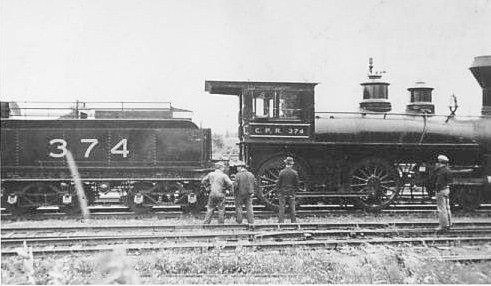The most important step in the development of British Columbia after joining Confederation in 1871 was the construction of the Canadian Pacific Railway. The transcontinental railway was started in 1880 and finished in 1885. It linked the new province to the rest of the country.
The mountains and canyons of British Columbia proved to be the toughest phase of construction. Andrew Onderdonk was the main contractor and he accomplished the work by hiring over 15,000 workers from China due to the shortage of labour in the province.
Immigrant workers lived in primitive huts and tents along the tracks. About 5,000 Chinese workers died in the building of the railway, and were buried where they fell, in makeshift, unmarked graves.
With lumber and supplies in demand businesses along the line flourished. Many of these died when construction ended but some survived and prospered.
Ashcroft was one of these communities that survived and prospered. In 1883 Barnes and Evans anticipating business erected a hotel down by the River, and by the fall of 1884 the CP tracks were going right through the middle of their grain fields. Not to be undaunted the hotel was dismantled and moved up to the main flat across from the station. Once the rail was complete the town site was the most northern point on the CP Rail, this brought the opportunity to supply the North Country.
February 19, 1885 Notes By A Traveler “At Barnes and Evans ‘times are lively. The end of Cariboo road expected to connect at this point with the Railway. Report has it that the Bridge Crossing has been decided upon” (Savona in the Early Years)
By 1886 a bridge was built and a wagon road connected the rail to the north. Two more hotels sprang up on Railway to join Barnes and Evans’. Ashcroft replaced Yale as the “Gateway to the Cariboo”.
In 1883 the Canadian Pacific began to design its own locomotives, they opened shops in Montreal, where the first locomotives were built. Between May and July, 1886, a group of eight passenger locomotives, were constructed and numbered 371-378. This group of engines was sent west and operated between North Bend and Port Moody. No. 374, hauled the first passenger train, carrying 150 passengers, to go beyond Port Moody over the 12 mile extension to Vancouver on May 23rd, 1887, thus finally joining Canada from East to West. (Locomotive No. 374 A Historic Summary)www.wcra.org/engine/374
Last week the Ashcroft Museum had the privilege of a visit from David Cheung and his sons. David’s wife’s great-grandfather was among those Chinese that worked on the construction of the railway. The Cheung family now reside in Toronto and their journey has brought them to the interior of BC in a quest to visit the places that their ancestors toiled, and to collect submissions of art work. They are hoping to collect at least 5000 pieces to represent the number of workers that lost their lives. This artwork will be displayed on their website www.rockyrailwayhigh.com, and then will be buried in Guandong, China where many of the workers originated.
We invite you into the museum to create a poem or art work to add to the Rocky Mountain High project.
Also on display in the Museum to commemorate the 125 years of CP rail is a model of Engine #374. This model was built by Stallard McConnell of Ashcroft and is a must see!
The Museum is open Monday to Friday 9am to 5 pm and Saturday and Sunday 12 noon until 8 pm. Regan and Kathy would be pleased to show you around and answer any questions you may have.
